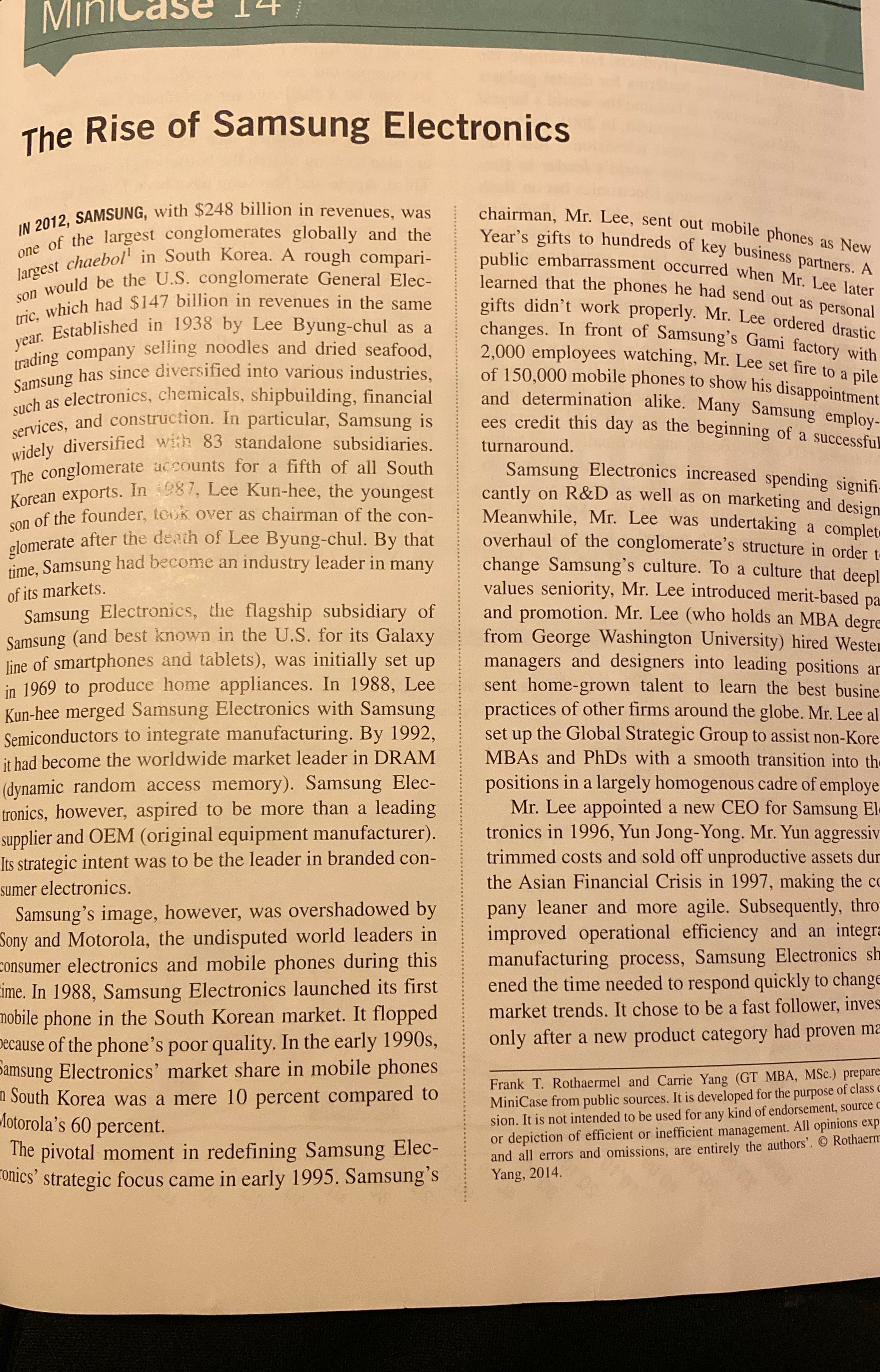1. Describe Samsung as a conglomerate . What type of diversification does Samsung pursue? Identify possible factors such as core competencies, econo mies of scale, and economies of scope that migh underlie its success as a diversified conglomerate (chaebol). Which do you consider its key success factors?2. What can Samsung Electronics do to sustain its competitive advantage in smartphones ? Should Samsung change its " follow first, innovate second approach as it seeks to build a competitive position in new product areas other than smartphones ?
MiniCase 15 The Rise of Samsung Electronics IN 2012, SAMSUNG, with $248 billion in revenues, was one of the largest conglomerates globally and the chairman, Mr. Lee, sent out mobile phones as New largest chaebol' in South Korea. A rough compari- Year's gifts to hundreds of key business partners. A son would be the U.S. conglomerate General Elec- public embarrassment occurred when Mr. Lee later tric, which had $147 billion in revenues in the same learned that the phones he had send out as personal year. Established in 1938 by Lee Byung-chul as a gifts didn't work properly. Mr. Lee ordered drastic trading company selling noodles and dried seafood, changes. In front of Samsung's Gami factory with Samsung has since diversified into various industries, 2,000 employees watching, Mr. Lee set fire to a pile such as electronics, chemicals, shipbuilding, financial of 150,000 mobile phones to show his disappointment services, and construction. In particular, Samsung is and determination alike. Many Samsung employ widely diversified with 83 standalone subsidiaries. ees credit this day as the beginning of a successful turnaround. The conglomerate accounts for a fifth of all South Korean exports. In 1987, Lee Kun-hee, the youngest Samsung Electronics increased spending signifi son of the founder, took over as chairman of the con- cantly on R&D as well as on marketing and design glomerate after the death of Lee Byung-chul. By that Meanwhile, Mr. Lee was undertaking a complet time, Samsung had become an industry leader in many overhaul of the conglomerate's structure in order of its markets. change Samsung's culture. To a culture that deepl Samsung Electronics, the flagship subsidiary of values seniority, Mr. Lee introduced merit-based pa Samsung (and best known in the U.S. for its Galaxy and promotion. Mr. Lee (who holds an MBA degre line of smartphones and tablets), was initially set up from George Washington University) hired Weste managers and designers into leading positions an in 1969 to produce home appliances. In 1988, Lee sent home-grown talent to learn the best busine Kun-hee merged Samsung Electronics with Samsung practices of other firms around the globe. Mr. Lee al Semiconductors to integrate manufacturing. By 1992, set up the Global Strategic Group to assist non-Kore it had become the worldwide market leader in DRAM MBAs and PhDs with a smooth transition into th (dynamic random access memory). Samsung Elec- positions in a largely homogenous cadre of employe tronics, however, aspired to be more than a leading Mr. Lee appointed a new CEO for Samsung E supplier and OEM (original equipment manufacturer). tronics in 1996, Yun Jong-Yong. Mr. Yun aggressive Its strategic intent was to be the leader in branded con- trimmed costs and sold off unproductive assets du sumer electronics. the Asian Financial Crisis in 1997, making the c Samsung's image, however, was overshadowed by pany leaner and more agile. Subsequently, thro Sony and Motorola, the undisputed world leaders in improved operational efficiency and an integr consumer electronics and mobile phones during this manufacturing process, Samsung Electronics sh ime. In 1988, Samsung Electronics launched its first ened the time needed to respond quickly to change mobile phone in the South Korean market. It flopped market trends. It chose to be a fast follower, inve ecause of the phone's poor quality. In the early 1990s, only after a new product category had proven ma amsung Electronics' market share in mobile phones South Korea was a mere 10 percent compared to Frank T. Rothaermel and Carrie Yang (GT MBA, MSc.) prepare MiniCase from public sources. It is developed for the purpose of class fotorola's 60 percent. sion. It is not intended to be used for any kind of endorsement, source The pivotal moment in redefining Samsung Elec- or depiction of efficient or inefficient management. All opinions exp and all errors and omissions, are entirely the authors'. O Rothaern onics' strategic focus came in early 1995. Samsung's Yang, 2014







